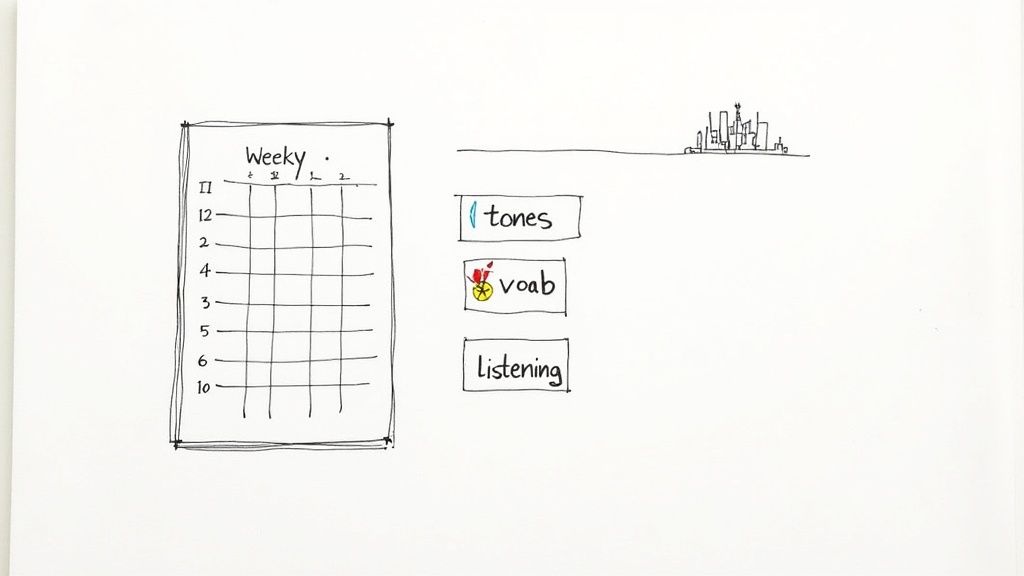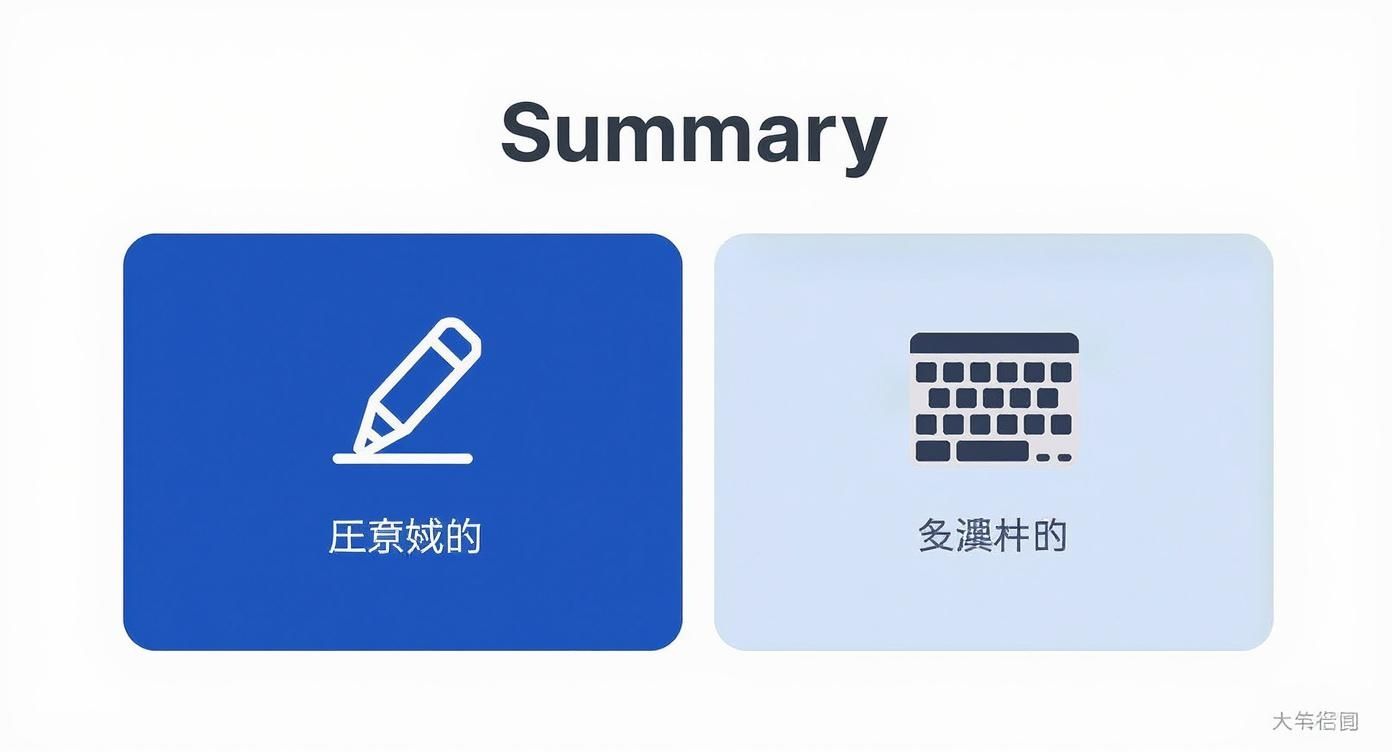How to Improve in Chinese A Practical Guide
To really get better at Chinese, you need a fundamental shift in how you approach it. Move away from that rigid, academic mindset and start thinking about active, daily engagement. The real secret is consistency over intensity. It's far better to practise for just 15 minutes a day than to cram for hours once a week. This turns learning from a chore into a sustainable habit that actually sticks.
Build a Strong Foundation for Your Mandarin Journey
Before you even think about memorising thousands of characters or getting bogged down in complex grammar, you need to build a solid foundation that’s tailored to you. So many learners, especially here in Singapore, fall into the trap of treating Mandarin like just another subject to pass an exam in.
Real, lasting improvement only begins when you see it as a living, breathing language—a tool for connection and understanding. That change in perspective is absolutely crucial.
This is especially true given Singapore's unique linguistic backdrop. The number of ethnic Chinese Primary One students from primarily English-speaking homes has shot up over the last two decades. It’s a clear sign of a broader societal shift towards English, which presents a real challenge for mastering Mandarin. While nearly half (47.7%) of Chinese Singaporeans say Mandarin is their main home language, this figure is dropping. A notable 19.2% still speak other Chinese dialects at home.
Assess Your Starting Point
First things first: be honest with yourself about where you stand right now. Are you starting from absolute zero, or are you trying to dust off those rusty skills from your school days? Your entire strategy hinges on this. A frank self-assessment helps you set goals that are actually achievable and saves you from the frustration of tackling material that's way too hard or mind-numbingly easy.
To get a clearer picture, think about the four core skills and pinpoint which one needs the most attention:
- Listening (听力 tīnglì): Can you pick out words in a slow conversation, or does it all sound like a blur?
- Speaking (口语 kǒuyǔ): Are you okay with forming simple sentences, or does the fear of making a mistake keep you silent?
- Reading (阅读 yuèdú): Do you recognise common characters, or do you find yourself stuck on every other word?
- Writing (写作 xiězuò): Are you just focused on typing with Pinyin, or do you want to get the hang of handwriting characters?
Identifying your weakest link is the first step toward balanced improvement. Focusing your initial efforts on that one area can build confidence and create momentum for tackling the others.
Once you know what to focus on, you can start building a study plan that actually fits your life. A self-directed approach is powerful, and for more on that, you might find this guide to self-directed learning quite useful.
Four Pillars of Chinese Language Proficiency
To help you get started, here's a quick look at the four core skills and what you should focus on at different stages. Think of it as a roadmap for building a well-rounded ability in Mandarin.
| Core Skill | Beginner Focus | Intermediate Focus |
|---|---|---|
| Listening (听力) | Recognising Pinyin sounds and tones. Understanding basic greetings and simple questions. | Following short conversations on familiar topics. Catching keywords in faster speech. |
| Speaking (口语) | Mastering tones. Introducing yourself and asking simple "who, what, where" questions. | Expressing opinions. Describing past events and future plans. |
| Reading (阅读) | Recognising the 100-200 most common characters. Reading simple signs and short sentences. | Reading graded readers and short online articles. Understanding the main idea of a text. |
| Writing (写作) | Learning basic stroke order. Typing in Pinyin. Writing simple sentences about yourself. | Composing short paragraphs. Writing messages to friends. Typing more efficiently. |
Remember, the goal isn't to be perfect at all four from day one. It's about making small, consistent progress across the board.
Create a Realistic Study Plan
Forget about those marathon cramming sessions on the weekend. The most effective path to improving your Chinese is through consistent, daily practice. A sustainable routine is infinitely more powerful than sporadic, intense study sessions because it gives your brain the regular exposure it needs to build new pathways.
Your plan doesn't need to be some grand, complicated affair. It could be as simple as this:
- 15 minutes of a Chinese podcast on your morning commute.
- 10 minutes of reviewing flashcards on an app like Pleco during your lunch break.
- 20 minutes of a graded reader before you go to sleep.
That adds up to 45 minutes of practice woven into your day, without ever feeling like a burden. The goal is to make Mandarin a natural, effortless part of your daily rhythm.
While self-study is fantastic, the right structured environment can really speed things up. It’s always smart to explore your options. If you're considering a more formal setting, our insights on choosing the right https://spanish.sg/blog/language-school-in-singapore could point you in the right direction.
Master Listening and Speaking in the Real World
True fluency in Chinese isn't built in the silent halls of a library. It’s forged out in the real world—amidst the chatter of coffee shops and the hustle of daily life. For many of us in Singapore, the main hurdle is simply finding chances to practise in what is often an English-first environment.
The secret is to start weaving Chinese into your existing routine. You don't need a plane ticket to Beijing to get immersed; your daily life here is packed with untapped potential. The goal is to first train your ear to the natural cadence of Mandarin and then build the confidence to speak, even if you start with just a few simple phrases.
Tune Your Ears to Singaporean Mandarin
Active listening isn’t just about hearing words. It’s about catching the context, the tone, and all the little nuances that give language its flavour. Before you can speak with any real confidence, you need to get comfortable with how Mandarin actually sounds in day-to-day situations, complete with local accents and slang.
A simple first step is to tweak your media habits. On your next commute, instead of your usual Spotify playlist, tune into a local Chinese radio station like YES 933. The mix of pop songs, DJ chatter, and ads is a fantastic, low-pressure way to hear Mandarin used naturally.
Here are a few other great resources tailored for us here in Singapore:
- Local TV Dramas: Fire up meWATCH and put on a local drama. You'll pick up on vocabulary and sentence structures that are actually used here, which is far more practical than watching content made for a mainland Chinese audience.
- Singaporean Podcasts: Search for podcasts by local creators. Whether it's news analysis or a comedy show, you’ll get to hear authentic, unscripted conversations while you’re at the gym or doing chores.
The point isn't to understand every single word right away. Just try to absorb the rhythm of the conversation. Focus on pulling out keywords and getting the general vibe. This kind of passive listening is a powerful foundation.
From Listening to Speaking
Making the leap from understanding to actually speaking is often the scariest part. That fear of saying something wrong can be paralysing, but it’s a wall you have to push through. Every mistake is a learning moment, not a failure.
Start small, in situations where the stakes are low. The next time you're at a hawker centre, try ordering your kopi or chicken rice in Mandarin. Even a simple "我要一个鸡饭 (wǒ yào yī gè jī fàn)" is a victory. The uncle or auntie will understand you, and you'll have just used your Chinese in a real-world transaction.
This approach of learning by doing and observing is backed by social learning theory, which basically says we learn a huge amount just by watching and interacting with others in a social setting.
Find Your Speaking Tribe
Nothing accelerates progress like consistent practice, and for that, you need people. Talking with others gives you instant feedback and pushes you beyond stiff textbook phrases into the flow of real, dynamic conversation.
The key is to create a supportive space where you feel safe enough to try—and even mess up. You’ve got plenty of options right here in Singapore. For instance, teaming up with a practice partner can work wonders, and our guide on setting up a language exchange in Singapore is a great place to start.
You could also explore other avenues for regular speaking practice:
- Join a Club: Find a club based on your hobbies—like board games or hiking—that has Mandarin-speaking members. The shared activity takes the pressure off.
- Volunteer: Look for chances to help out where you can interact with Mandarin-speaking seniors or other community members.
- Find a Tutor: A good tutor provides a judgement-free zone where you can practise, get corrected, and ask all the questions you want.
Ultimately, the aim is to make speaking Chinese a normal part of your week. The more you use it, the more natural it feels. Every little conversation, no matter how brief, strengthens those connections in your brain and makes the next one just that little bit easier.
Unlock Chinese Characters and Boost Your Reading Skills
Staring at a page of Chinese characters can feel like trying to climb a mountain without a map. But I'm here to tell you something that might sound surprising: you don't need to memorise thousands of them to read confidently. The game has completely changed, and smart strategies now make reading Chinese more achievable than ever.
The secret is to stop thinking of characters as thousands of unique, complex pictures. Instead, you need to learn to see the simple, logical patterns inside them. This simple shift in mindset turns a monumental task into a fascinating puzzle you can actually solve.
This is especially true here in Singapore, where Mandarin isn't just a subject in school—it's a living language all around us. In fact, 52% of the resident population speaks Standard Chinese, making it one of the most common languages you'll encounter daily. Even our education policies have evolved; allowing Chinese handheld dictionaries in exams since 2006 shows a move towards practical language use. For more on how Chinese is spoken globally, check out the data at WorldPopulationReview.com.
Decode Characters by Learning Their Building Blocks
The ultimate shortcut to making sense of Chinese characters is understanding radicals (部首 bùshǒu). Think of them as the fundamental building blocks. Most complex characters are just combinations of these simpler components, and radicals often give you a massive clue about the character's meaning or even its sound.
It's a bit like learning prefixes in English. Once you know "un-" means "not," you can instantly make a good guess at words like "unhappy" or "unclear." Radicals work the same way.
Take the "three-dots-water" radical (氵), for example. Whenever you see it, you can bet the character has something to do with water or liquid:
- 河 (hé) – river
- 湖 (hú) – lake
- 海 (hǎi) – sea
By focusing on the 214 common radicals, you're not just memorising little pictures. You're learning a powerful system to decode characters you've never even seen before. It makes the whole process feel less like memorisation and more like detective work.
Read More, and Read Smarter, with Graded Readers
If you're just starting, picking up a copy of Lianhe Zaobao is a recipe for frustration. The most effective way to build real reading fluency is to use materials that are just a tiny bit challenging, but not overwhelming. This is exactly what graded readers are for.
These are books and stories written with a specific, limited vocabulary tailored to different learning stages (from HSK 1 up to HSK 6 and beyond). They let you get through a whole story without constantly reaching for the dictionary, which is crucial for building momentum and confidence.
Reading a lot of level-appropriate material is probably the single best thing you can do to get better. It’s what moves you from slowly sounding out characters one-by-one to actually understanding the flow of a sentence. Your brain starts recognising words in context, and that’s when real comprehension happens.
Today, there are fantastic apps and websites with huge libraries of graded content, from simple folktales to news articles rewritten for learners. You'll always have something interesting to read that's at your level.
Have a Game Plan for Every New Text
When you're faced with a new article or story, don't just dive in headfirst from the first word. Having a simple strategy makes the whole experience less intimidating and way more effective.
Here’s a practical approach I recommend:
- Do a Quick Scan First. Before you try to read properly, just let your eyes wander over the text. Look for any characters or words you already recognise. This gives you an immediate foothold and a general sense of what the text is about.
- Use Context as Your Friend. Your first instinct for an unknown word shouldn't be the dictionary. Look at the words and sentences around it. More often than not, the context gives you enough clues to make a pretty good guess.
- Use Digital Tools, but Wisely. When you're genuinely stuck, a dictionary app like Pleco is a lifesaver. But think of it as your last resort, not your first move. The real goal is to train your brain to figure things out on its own, not to become dependent on a translator.
Combine these three pillars—understanding radicals, reading consistently with graded materials, and using a smart reading strategy—and you'll find that mountain of Chinese characters starts to look a lot more like a hill you can definitely climb.
Develop Practical Chinese Writing and Typing Skills
When you hear "writing Chinese," it's easy to picture a calligraphy brush and ink. While that art form is incredible, the modern reality is all about tapping on screens and keyboards. To get genuinely good at Chinese today, you need to master both the digital and the traditional, but with a sharp focus on what’s practical for everyday life.
This really boils down to getting comfortable with Hanyu Pinyin input methods. This is the system that lets you type out Chinese characters using the familiar Roman alphabet, and it's the essential bridge connecting everything you've learned from listening and reading to your ability to actively communicate. The goal is to make writing—whether by hand or on a device—feel like a natural extension of your thoughts.
Master Pinyin Typing for Everyday Communication
Let's be realistic: for most of your daily interactions, from firing off a message on WhatsApp to drafting an email, typing is going to be your go-to. The great news is that if you've been working on your pronunciation, you've already got a massive head start on learning to type.
Getting this set up is surprisingly simple. Your phone and computer both have built-in options to add a Chinese keyboard. Once it's on, you just type the Pinyin for a word, and a menu of characters pops up for you to select. For example, typing "nihao" brings up 你好. Easy.
To get truly fast and fluid with it, try a few of these tricks:
- Switch Your Device Language: This one is bold, I know, but it works. Flip your phone's system language to Mandarin for a week. You’ll be forced to learn the characters for all those everyday functions you take for granted.
- Message Friends in Chinese: Start a chat group with fellow learners or Mandarin-speaking friends. Make a pact to only use Chinese in that chat.
- Write Short Social Media Posts: Try crafting a simple, one-sentence caption in Chinese for your next Instagram post. It’s a low-pressure way to connect the language directly to your own life.
The real aim is to move past that clumsy, character-by-character search and make typing feel effortless. The more you do it, the more you'll start to anticipate the characters you need, and your speed will improve dramatically.
Don't Forget the Fundamentals of Handwriting
Even in our digital-first world, there's a unique power in knowing how to write characters by hand. It forces you to pay close attention to the components and structure of each character, which cements them in your memory in a way that typing just can't replicate.
The single most important principle here is stroke order (笔顺 bǐshùn). It's not just about making your characters look neat; following the correct sequence is fundamental to writing efficiently and making your handwriting legible. The rules are surprisingly logical—you generally write from top to bottom, left to right, and outside to inside.
You don't need to spend hours on drills. Just weave it into your existing study routine:
- Trace Characters: Use an app like Skritter or just trace characters in a workbook. This is all about building muscle memory for the correct patterns.
- Write Out Your Flashcards: Instead of just reading your flashcards, take an extra second to write the character from memory. This active recall is incredibly effective for making things stick.
- Keep a Simple Journal: Try writing just one or two sentences in a notebook each day. It could be about what you did, the weather, or a new word you learned.
Bridge the Gap Between Reading and Writing
Ultimately, the goal is to close the loop between what you can understand and what you can actually produce yourself. The most direct way to do that is through active writing practice, using the sentence patterns and vocabulary you’ve picked up from reading and listening.
Think of it as reverse-engineering. When you come across a useful sentence, pause for a moment and break down its structure. Then, try to create a new sentence about your own life using that same pattern. For example, you might read:
"我今天下午要去图书馆 (Wǒ jīntiān xiàwǔ yào qù túshūguǎn)" – "I am going to the library this afternoon."
Now, swap out the pieces to make it your own:
- "我今天晚上要去健身房 (Wǒ jīntiān wǎnshàng yào qù jiànshēnfáng)" – I am going to the gym tonight.
- "我明天早上要去公司 (Wǒ míngtiān zǎoshang yào qù gōngsī)" – I am going to the office tomorrow morning.
This simple exercise actively turns passive knowledge into a tool you can genuinely use. For learners who want to structure this practice more effectively, exploring online tutoring opportunities can be a great way to get personalised feedback and accelerate the process.
Integrate Mandarin into Your Daily Singaporean Life
The real secret to making headway with Chinese isn't tucked away in a textbook. It’s found by weaving the language into the very fabric of your everyday life. When you shift learning from a scheduled chore to an unconscious habit, you build a routine that actually sticks. The idea is to create your own personal immersion bubble, right here in Singapore.
Simple changes to your daily actions can create a powerful, passive learning environment. It’s all about seizing those small moments—the commute, the lunch break, the evening scroll—and infusing them with a little Mandarin. You don't need to block out huge chunks of time; you just need to be clever with the time you already have.
Transform Your Digital World
Let’s be honest, your smartphone is probably the first thing you see in the morning and the last thing at night. That makes it one of the most powerful language-learning tools you own. With just a few tweaks, you can turn screen time into valuable study time, almost without trying.
One of the boldest moves you can make is to switch your phone’s system language to Mandarin. I know it sounds daunting, but it forces you to learn practical, high-frequency vocabulary for functions you use every day, like "settings" (设置), "messages" (信息), and "camera" (相机). After the initial shock wears off, you’ll be surprised at how quickly you adapt.
Another easy win is to curate your social media feeds. Follow a few Mandarin-speaking Singaporean influencers, news outlets, or content creators. This exposes you to colloquial language and local slang in a format you're already scrolling through anyway.
Turn Everyday Errands into Language Missions
Living in Singapore gives you a unique advantage. While English is everywhere, so is Mandarin—if you just start paying attention. Begin treating your daily errands as mini-missions to use your Chinese skills in low-stakes, real-world situations.
Here are a few ideas to get you started:
- At the Hawker Centre: Instead of pointing, try ordering your food and drinks in Mandarin. A simple "一个鸡饭, 谢谢 (yī gè jī fàn, xièxie)" is a small victory that builds massive confidence.
- On the MRT: Listen to the announcements and look at the digital signs. Can you spot the characters for the next station (下一站)? This simple act connects written characters to real places.
- Go Grocery Shopping: Take a moment to read the labels on products. Try to identify the characters for common items like fruits (水果), vegetables (蔬菜), or meat (肉).
The key is to shift from being a passive observer to an active participant. Each small interaction, no matter how brief, reinforces what you’ve learned and proves that your skills have real-world value.
This graphic shows the two main ways we 'write' Chinese in the modern world: by hand and by keyboard.
It highlights an important point: while handwriting is brilliant for memorising characters, typing is essential for day-to-day communication.
The best way to make these habits stick is to choose activities that match your current skill level. You want to feel challenged, not overwhelmed.
Daily Immersion Techniques for Different Proficiency Levels
This table breaks down some practical ways to integrate Chinese into your daily life, categorised by skill level for easy application.
| Activity | Beginner Level | Intermediate Level | Advanced Level |
|---|---|---|---|
| Media Consumption | Watch kids' cartoons with subtitles. Listen to simple songs like nursery rhymes. | Watch Singaporean dramas with Chinese subtitles. Listen to podcasts on familiar topics. | Watch news reports or documentaries without subtitles. Listen to talk radio or debates. |
| Social Media | Follow accounts that post a "word of the day" or simple infographics. | Follow influencers or news pages. Try reading and understanding comments. | Actively participate in discussions by leaving comments or making your own posts. |
| Reading Material | Read children's storybooks or graded readers. Identify characters on signs. | Read short news articles or blog posts. Read bilingual magazines. | Read novels, opinion pieces, or technical articles in Mandarin. |
| Daily Interactions | Use basic greetings and order food at a hawker centre. | Ask for directions or make simple inquiries at a shop. | Discuss current events with a taxi uncle or have a detailed conversation with a vendor. |
Starting with activities suited to your level makes the process enjoyable and helps build the confidence you need to tackle more complex challenges later on.
Engage with Culture to Deepen Your Connection
Learning a language is about so much more than just words and grammar; it’s about connecting with a culture. Immersing yourself in the cultural side of Mandarin can spark your motivation and provide the rich context that makes the language truly come alive.
Plan a visit to the Singapore Chinese Cultural Centre or just wander through Chinatown. These experiences are a feast for the senses and connect you to the history behind the language. The goal is to create positive, memorable experiences that you associate with Mandarin.
Even Singapore’s education system gets this, offering different tiers of Chinese based on a student's background. Students can opt for standard, higher, or Syllabus B levels—a smart system designed to support weaker learners while challenging stronger ones. This reflects a wider understanding that real improvement comes from a mix of classroom learning and real-world reinforcement. You can discover more about Singapore's approach to language education from the official statistics.
By weaving these small habits into your routine, you transform the city itself into your classroom. Every sign becomes a flashcard, every conversation a lesson, and every cultural experience a reason to keep going. This is how you improve in Chinese in a way that feels natural, sustainable, and genuinely rewarding.
Got Questions About Learning Chinese? We've Got Answers.
Jumping into learning Chinese, or even just picking it up again, always kicks up a few questions. How long until I can actually order coffee without a panic attack? What's the secret to making all these characters stick? And don't even get me started on the tones.
If you've asked yourself any of these, you're in good company. Every single learner hits these same hurdles. Let's cut through the confusion and get you some straight, practical answers so you can keep your momentum going.
How Long Until I'm Actually Conversational?
This is the million-dollar question, isn't it? There's no one-size-fits-all answer, as it really boils down to your background, how much you practise, and what you focus on. But we can definitely set some realistic goals.
If you're starting from scratch and can put in a solid 5-10 hours of focused learning a week, you could find yourself at a basic conversational level (think HSK 3) in about 6 to 12 months.
For many Singaporeans just dusting off their school-day Mandarin, you've got a head start, so that timeline can shrink quite a bit. The real key isn't about cramming; it's about consistency. A little bit every day beats a marathon session once a week. My best advice? Zero in on vocabulary for topics you genuinely care about and will actually talk about. This gets you speaking much faster than trying to memorise the entire dictionary.
What's the Best Way to Remember All These Characters?
Trying to memorise thousands of characters by sheer force of will is a fast track to burnout. The smarter way to do it is to learn the radicals first. These are the basic components that make up more complex characters, and they often give you a clue about the meaning or sound. Think of them as the ultimate cheat code.
Another great trick is to create little stories or mental images to connect the parts of a character. For example, the character for "good" is 好 (hǎo). It’s made up of 女 (nǚ, woman) and 子 (zǐ, child). A simple story like "a mother with her child is a good thing" makes it instantly memorable.
Don't sleep on modern tools. Apps like Pleco or Skritter are game-changers. They use spaced repetition systems (SRS) to show you a character right before your brain is about to forget it. It's a scientifically proven method that works wonders.
Most importantly, learn characters in the wild. Seeing how a character is used in a real sentence makes it stick in your brain far more effectively than just staring at it on a flashcard.
How Can I Finally Fix My Terrible Pronunciation and Tones?
This might sound backward, but getting the tones right starts with your ears, not your mouth. Before you can say them correctly, you have to be able to hear the difference clearly. Spend a lot of time just listening to native speakers, really focusing on the musical rhythm and the up-and-down flow of their speech. Some apps can even show you the tone shapes visually, which helps connect what you're hearing to what you need to do.
Once you’re tuned in, it's time to try the shadowing technique. It’s incredibly powerful.
- First, find a short audio clip of a native speaker saying a sentence or two.
- Listen to it once just to understand it.
- Then, play it again and try to speak along with them, almost at the same time. Your goal is to copy their exact pitch, rhythm, and speed.
Don't be shy about exaggerating the tones when you start. Make the high tones extra high and the falling tones extra sharp. This helps build the muscle memory you need. Recording yourself and playing it back against the original audio is also a brilliant way to catch your own mistakes. It can be a bit cringey at first, but it works.
Should I Learn Simplified or Traditional Characters?
If you're living and learning in Singapore, mainland China, or Malaysia, this one is an easy call: learn Simplified characters.
Simplified is the official script used for everything—from government signs and school textbooks to news websites and restaurant menus. It's what you'll see and use every single day.
While Traditional characters are beautiful and hold a lot of history, focusing on Simplified first is the most practical choice. It ensures the Chinese you learn is immediately useful in your environment.
At Spanish Council Singapore, we know that having an expert guide you can make all the difference when you're mastering a new language. While we live and breathe Spanish, the principles of effective learning—structured practice, real-world immersion, and personalised support—are universal. See how our proven teaching methods can help you smash your language goals at https://spanish.sg.















